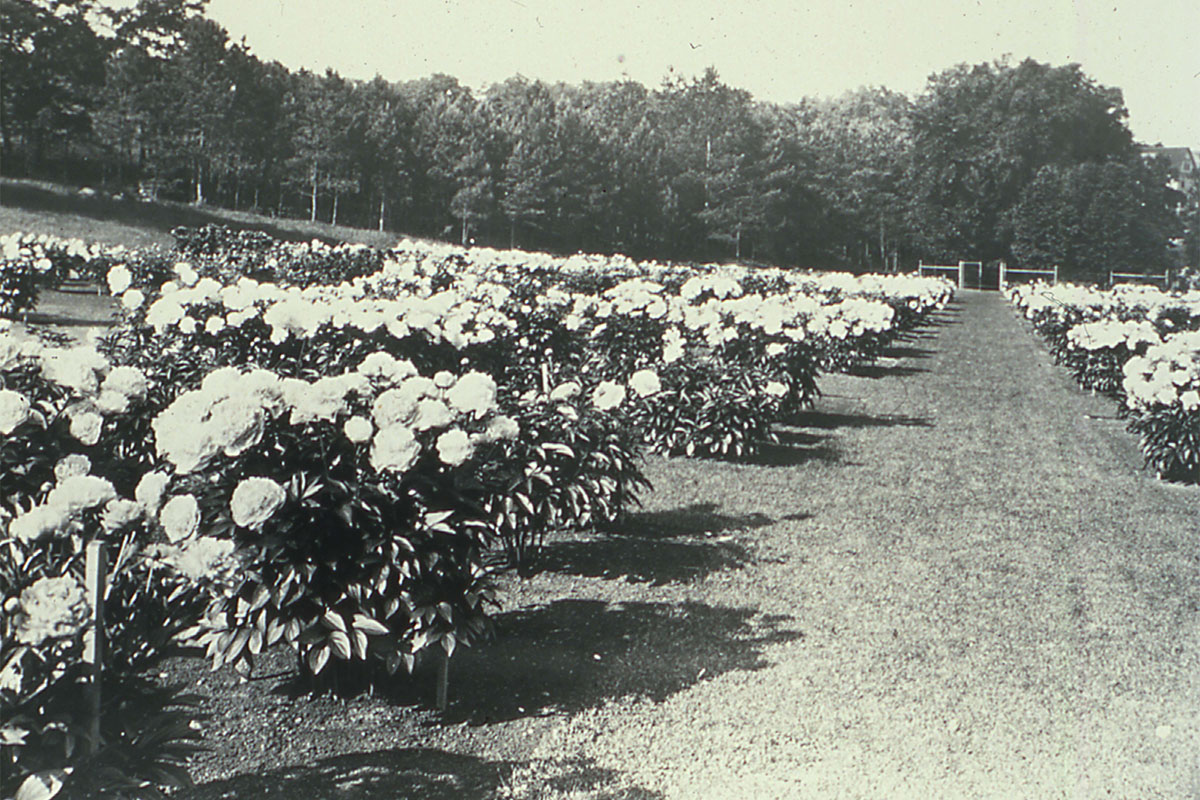Peony Garden First Century
The Beginning
In the early 20th Century, several major American universities had peony gardens, both for beauty and study. The first was at Cornell University.
In 1922 the Regents of the University of Michigan appropriated $2,000 to establish the Peony Garden at the Nichols Arboretum. A critically-evaluated and large collection of herbaceous peonies was being offered by Dr. W. E. Upjohn, an alumnus of the University of Michigan (1875) and founder of the Upjohn Pharmaceutical Company in Kalamazoo, Michigan.
Dr. Upjohn contributed peonies from his own extensive collection, and nationally recognized experts and nursery owners donated exceptional selections.
In 1928 the Regents acknowledged a resolution by the Directors of the American Peony Society, recognizing the potential significance of the Peony Garden at the Nichols Arboretum.
Dr. Upjohn was a passionate collector and evaluator of herbaceous peonies as well as a nationally noted philanthropist. He was active in the American Peony Society, serving as Treasurer for a term beginning in 1923.
His personal estate near Kalamazoo held over 600 cultivars across at least 14 acres of peony beds. Dr. Upjohn enjoyed opening his private collection to the public – free of charge – during the bloom season.
He also kept meticulous track of his peonies and privately published Brook Lodge Gardens – Peonies. This booklet, published after 1922, contains his articulate opinions of the virtues and diverse intriguing facts peony by peony.
About Dr. Upjohn
Further information about Upjohn’s life can be found in his obituary, available from the on-line archives of the Kalamazoo Public Library, as well as the extensive family and corporate history in Keep the Quality Up by Martha Parfet and Mary Corcoran (2014).
Creating the
Peony Garden
The University’s Peony Garden was to increase understanding, knowledge, and appreciation of peonies, and was planned to include both herbaceous and tree peonies.
The formal garden of 27 beds was designed by the Arboretum’s director Aubrey Tealdi. These beds were only for herbaceous peonies – the tree peonies were to be on the slopes above the main peony beds.
Although the garden was initiated in 1922, it was not well-enough established to be open to the public until 1927. Tealdi brought national attention to the new garden by publishing two articles in the American Peony Society Bulletin. In 1929 he presented the history of its establishment, and in 1931 he solicited contributions of important varieties to expand the collection.
Standards were high. As can be seen in the historical photographs below, every plant was carefully staked and from the evidence, de-budded (side buds removed) in order to produce a single, stunning peony flower on each stem.

The Great Depression of the 1930s, followed by World War II put completing the peony garden out of anyone’s priority tasks. Those hundreds of peonies that had been planted and inventory mapped did what peonies do when they are happy – they bloomed and got larger.
Over the years and decades, the peony garden became a pilgrimage site during bloom season, but it was not deeply incorporated into the institution’s management culture.
As far as we can tell, it was not until about 1987 that community members, led by the Ann Arbor Chapter of the Woman’s National Farm and Garden Association, with assistance from Brook Lodge, began to revitalize the peony garden.
Their focus was preparing the Peony Garden for the Nichol’s Arboretum’s 90th Anniversary – as an example of the Arboretum’s collection serving educational roles.
More Information
Their Peony Garden Guide can be downloaded here (Note: some plant locations have changed since the booklet was published in 1996.
Rejuvenating the
Peony Garden
Visiting the Peony Garden has become an annual spring pilgrimage for visitors from Michigan and beyond.
Many visitors are stunned at the vast display. Some seek to find an organizing theme to each bed so they can better grasp the diversity. At present there is no simple organizing concept, so self-guided themed tours have been prepared for use on-site.


